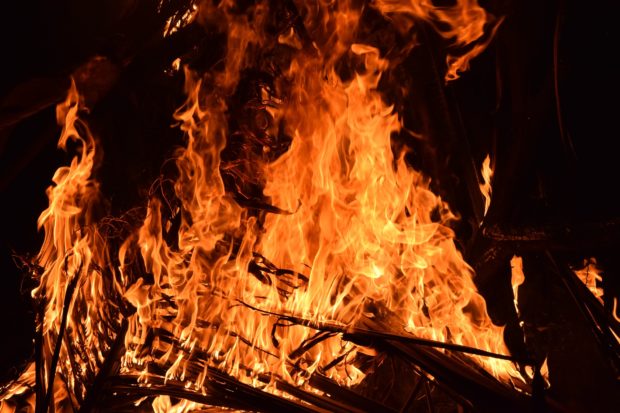You have no items in your cart. Want to get some nice things?
Go shopping
While a cornucopia of paper houses burn, I stand transfixed by the flames as they enter into the sky, the fire and smoke interlacing as both make their way into the rapidly-darkening horizon. Perhaps there was a prayer I could have uttered as this shrine of offerings was cleansed by the flames to join my grandfather beyond the mortal veil. Some eloquent last goodbye, proving that our bond as gōa-soon and gōa-kong had something more to it than just pleasantries at weekly lunches. But all I could do was continue to look at the flames as paper bills with inscriptions I couldn’t understand were continually consumed and rebirthed as ash.
It was the last day of funeral celebrations for my grandfather, and although I was surrounded by my family, I had never felt more out of place. A common aspect of Chinese ancestral worship, even among diaspora, is the burning of joss paper, paper-maché cars, microwaves, and other objects. These are meant to be veneration of the dead, a method of providing for them in death what they once had in life. Once, these beloved objects were buried in the graves with the dead themselves; now, miniature carbon copies take their place in altars and shrines all across the world, each a reminder of the deceased’s earthly possessions. In the end, perhaps it is these mementoes and relics, the ones that exist only to be bought and burnt up, that tell us the most about what we value.
I have probably never felt as connected to these traditions and practices as I should be, considering that the people who were participating in these rituals make up fifty per cent of my extended family, as my mother is one hundred per cent Chinese-Filipino. In films such as The Impossible and Cinema Paradiso, tragedies like these are meant to bring families closer together. In The Impossible, the sheer horror of the Indian Ocean tsunami is overshadowed by how the Bennetts manage to reunite and emerge stronger than ever before. Instead, in my personal tragedy, the wave I am faced with is the deluge of comments in Hokkien from distant cousins and aunties. The only action is me nodding blankly, trying to pretend I understand a single word they say. Spoiler: I don’t.
It makes perfect sense that we return to our ancestral roots in the face of loss. But that didn’t seem to help my situation when I was sitting blankly and trying to comprehend everything, when I knew (and still know) absolutely nothing. Maybe it is odd that I haven’t even learned the basics of a language I should probably be fluent in, but am I to blame when my parents only ever seem to speak their native languages behind my back? That just might be the thing about our roots and our traditions – if nothing else, we know them, and we know that they are unlikely to change any time soon.
Perhaps, though, that’s what we need to know about dealing with the ones that we love when they inevitably leave us. We all have our routines, our daily rituals. When the boats of our lives inevitably encounter rough waters, they are our life rafts, allowing us to at least attempt to begin anew, perhaps better than before. Then again, is it not these routines and practices that shackle us to the past?
As Warren Buffett once said, “Chains of habit are too light to be felt until they are too heavy to be broken.” Past the scent of burning paper and the chain of white-clad people that made up the funeral procession, maybe all of our rituals and all of our offerings were designed not for us to forget our past – but to create a new way forward, our memories merged with our most wanted wishes. Honouring our past, while embracing the future: isn’t that what we are constantly trying to work towards?
Before my grandfather’s passing, weekly Sunday lunches were always a treat: a time for my little brother to buy toys and a time for my extended family to actually interact with one another. With one less seat at the table, however, it sometimes feels as though as there is a spectre sitting at the dining room table with us. We once went to a different restaurant each week, but I have now memorized the order in which we go to these establishments, as dictated by my grandmother – first, Banana Leaf, second, Via Mare, third, Wooden Spoon, and fourth, Kaya. This weekly rotation of meals and malls is yet another routine, something meant to keep the train of life chugging right along even with a bump in the tracks.
If there is one thing therapists specializing in grief counselling can agree on, though, it is that there is no right way to grieve, or even a right amount of time to grieve for. Reports from the medical department of the University of California Davis say that expecting one to grieve for a year is but a myth, because it depends on the person, or the group of people. Some grieve through offerings and prayer, others through routines that attempt to include the person as if they were still here with them in some way, but as the saying goes, “to each their own”.
Some would say that a world where everyone goes through life with a perfect understanding of everyone else’s cultural traditions and practices is impossible. But respect isn’t understanding. We will all face loss at some point in our lives, and we all will try to find our little ways to cope. There will be times when we won’t ever truly “get” something, but that isn’t the point. All we have to do is give everyone their space, and a sign that we care. We don’t need to understand the exact purpose of what they’re doing, but we can appreciate it nonetheless. We must all continue to grieve, regardless of our individual sorrow. Life will go on despite our mistakes, our regrets, and our lost loved ones. That’s why on the path that we call our lives, the only possible direction is forward. Ashes to ashes, and dust to dust. If it is only in death that we are all truly equal; we must learn to respect the ways in which we are different before we all end up six feet under.

About Kody Tinga
Kody Tinga is a sophomore in a Filipino high school, who frankly, has no idea who he wants to be yet. Still, writing about what it means growing up as an international school student when still living in the same country he has resided in since birth has formed a large core of his writing, along with the ordeals of being a middle child. Currently, he lives in Manila, and spends his days walking his dogs, watching Netflix, and talking.




